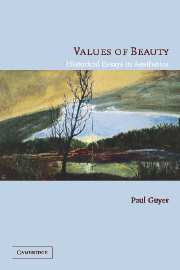Book contents
- Frontmatter
- Contents
- Introduction
- Acknowledgments
- Abbreviations Used in the Text
- I MOSTLY BEFORE KANT
- II MOSTLY KANT
- 3 The Harmony of the Faculties Revisited
- 4 Beauty and Utility in Eighteenth-Century Aesthetics
- 5 Free and Adherent Beauty
- 6 Kant on the Purity of the Ugly
- 7 Beauty, Freedom, and Morality
- 8 The Ethical Value of the Aesthetic
- 9 The Symbols of Freedom in Kant's Aesthetics
- 10 Exemplary Originality
- III MOSTLY AFTER KANT
- Bibliography of Works Cited
- Index
8 - The Ethical Value of the Aesthetic
Kant, Alison, and Santayana
Published online by Cambridge University Press: 05 June 2012
- Frontmatter
- Contents
- Introduction
- Acknowledgments
- Abbreviations Used in the Text
- I MOSTLY BEFORE KANT
- II MOSTLY KANT
- 3 The Harmony of the Faculties Revisited
- 4 Beauty and Utility in Eighteenth-Century Aesthetics
- 5 Free and Adherent Beauty
- 6 Kant on the Purity of the Ugly
- 7 Beauty, Freedom, and Morality
- 8 The Ethical Value of the Aesthetic
- 9 The Symbols of Freedom in Kant's Aesthetics
- 10 Exemplary Originality
- III MOSTLY AFTER KANT
- Bibliography of Works Cited
- Index
Summary
Western philosophy effectively begins with Plato's ban of most poetry from his ideal republic because of its immoral influence on the education of his guardians. Recently, there has been renewed debate about the relation between aesthetics and morality, with its focus on such questions as whether criticism of the moral attitudes expressed by a work of art is a proper part of aesthetic criticism of the work, whether works of art should be free of censorship or even eligible for public support regardless of the moral attitudes they may express, and whether the experience of art plays an indispensable role in the development of the capacity for moral reasoning and judgment. This debate has been revived after a long period of quiescence, at least in Anglo-American “analytical” aesthetics, where a rigid barrier had been maintained between aesthetics and ethics under the aegis of such slogans as the “autonomy of art” and “art for art's sake.”
This separation of the aesthetic and the ethical is usually thought to have been introduced into modern philosophy in the eighteenth century by such thinkers as the Third Earl of Shaftesbury and Francis Hutcheson, but above all by Immanuel Kant, whose “Analytic of the Beautiful” in his third great critique, the Critique of the Power of Judgment of 1790, opens with the claim that the “satisfaction that determines the judgment of taste is without any interest,” thus that the satisfaction “of the taste for the beautiful is a disinterested and free satisfaction; for no interest, neither that of the senses nor that of reason, extorts approval” (CPJ, §5, 5:210).
- Type
- Chapter
- Information
- Values of BeautyHistorical Essays in Aesthetics, pp. 190 - 221Publisher: Cambridge University PressPrint publication year: 2005
- 1
- Cited by

